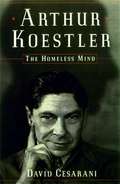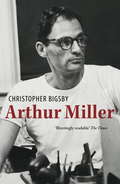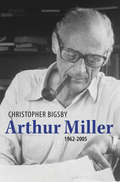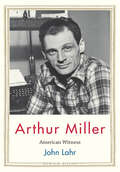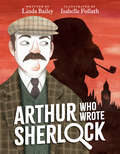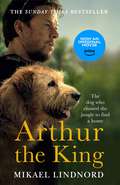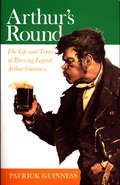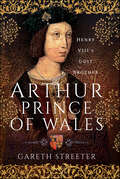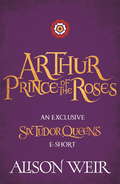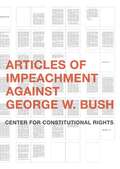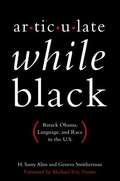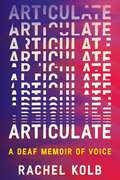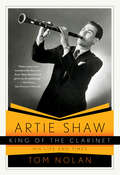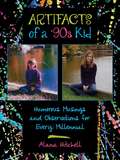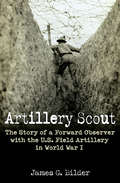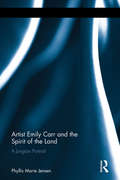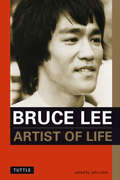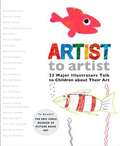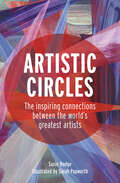- Table View
- List View
Arthur Koestler: The Homeless Mind
by David CesaraniArthur Koestler, best known for his world-famous novel Darkness at Noon, stands as a cultural beacon in the post-1945 world. Along with Sartre, Camus and Orwell, he helped to shape the ideas of today. This major reassessment, based on groundbreaking and comprehensive research, sets Koestler’s life and thoughts against the tumultuous century he chronicled and explores fully for the first time the continuing drama of his private life as a lover, a husband and a Jew. David Cesarani paints an explosive portrait of Koestler that bridges the gulf separating public and private life, contrasting the work of a genius against the backdrop of his tormented soul and brutal private life. In England, Cesarani’s revelations led to the removal of Koestler’s bust at the University of Edinburgh, so strong were the feelings roused by his dissection of Koestler as a thinker and as a man. A central European Jew born in 1905, Koestler was molded by his times. Uprooted by war and revolution and hounded by prejudice, he struggled to make sense of a world on the edge of apocalypse. His search for meaning, identity and belonging swept him up in the raging ideological torrents of his times--Zionism, Communism, anti-Communism and both hard scientific and esoteric mystical pursuits--and culminated in an idiosyncratic and deeply personal ideological position that has confused and eluded critics and commentators. Equally restless in his personal relationships, Koestler made and broke friendships and marriages. His violent affairs with women were legendary, but until now the shocking details of his private life were hidden from view by loyal friends and obscured by the Olympian prose of his autobiographical writing. Cesarani is the first to make unrestricted use of Koestler's private papers. He also draws on previously secret documents held by the KGB and the FBI, which expose the depth of Koestler’s involvement in the Communist Party and, later, his relations with the CIA. Once a Communist, Koestler eventually rejected Marxism and led the intellectual counterattack that culminated in the fall of the Berlin Wall. His speculations on human nature and the future of mankind in the atomic age were stamped upon a generation that lived in the shadow of the bomb. But alongside his brilliance and charm was a darker side, fully plumbed here for the first time, which led ultimately to the tragic dual suicide with his third wife, Cynthia, in 1983. With Arthur Koestler: The Homeless Mind David Cesarani has ensured Koestler’s place in the pantheon of the intellectual giants of the twentieth century as surely as his forceful, provocative and groundbreaking study is guaranteed to reignite the controversy that swirled around Koestler in his life and his death, in his work and his actions.
Arthur Mee: A Biography
by Keith CrawfordArthur Mee (1875-1943), best remembered as the creator of The Children's Encyclopaedia, was more than a popular editor, journalist and travel writer; for a generation of young readers and their parents, the name Arthur Mee truly meant something. Formany in his audience, the narratives and discourses embedded within his writing tied together and legitimised a trinity of beliefs that lay at the heart of his nonconformist faith and character: God, England and Empire. Despite the enormous appeal of his many published works, which during the first half of the twentieth century saw him become a household name and a major publishing brand, Mee has remained an ethereal figure. In Arthur Mee, the first full-length account of Mee's life since 1946, Crawford draws upon a range of Mee's correspondence to offer for the first time a realistic picture of the man at work and at home as an antidote to the overly romanticised image attached to his name. The book places Mee's work within the wider cultural, political and social context of an England undergoing unparalleled societal change and technological advancement. Scholars of the history of education, children's literature and beyond will find much of interest in these pages, and childhooddevotees to Mee's publications may well find themselves transported back to a time of wonder, imagination and hope.
Arthur Miller: 1962-2005
by Christopher BigsbyBiography of one of the greatest of modern playwrights, Arthur Miller (1915-2005).This is the long-awaited biography of one of the twentieth century's greatest playwrights whose postwar decade of work earned him international critical and popular acclaim.Arthur Miller was a prominent figure in American literature and cinema for over sixty years, writing a wide variety of plays - including The Crucible, A View from the Bridge, All My Sons, and Death of a Salesman - which are still performed, studied and lauded throughout the world.Born in 1915 to moderately affluent Jewish-American parents, Miller wrote during a fascinating time in American history. The Great Depression was a period of deprivation for many that left an indelible mark on the national psyche, and, like many, Miller found hope for the beleaguered common man in Communism. The Second World War elevated the common man to war hero, but when the Cold War subsequently began, the ugly elements of American conservatism freely persecuted writers and artists who had embraced Communism. Miller was among them. His refusal to give evidence against others to the notorious House Un-American Activities Committee in 1956 gave him a heroic role to play. In that same year, Arthur Miller momentously married the young actress Marilyn Monroe, a marriage that remains famous to this day. Christopher Bigsby's gripping, meticulously researched biography, based on boxes of papers made available to him before Miller's death, offers new insights into their marriage, and sheds new light on how their relationship informed Miller's subsequent great plays. After his death in 2005, many respected actors, directors and producers paid tribute to Miller, calling him 'the last great practitioner of the American stage'. Christopher Bigsby's supremely authoritative biography does full justice to Miller's life and art.
Arthur Miller: 1962-2005
by Christopher BigsbyThe second volume of the definitive biography of one of the greatest modern playwrights, Arthur Miller (1915-2005).The first volume of Christopher Bigsby's award-winning biography of Arthur Miller was hailed as a masterpiece and the definitive account of Miller's early years. This is the second half of Miller's captivating story, covering his life from 1962 to his death in 2005.In 1962, Miller's legacy was incomplete. Ahead lay eighteen plays, five films, a novella and a handful of stories. On a personal level, 1962 saw the death of his second wife, the iconographic Marilyn Monroe, and his marriage to the photographer Inge Morath who was to transform him as a writer and a person. A visit to Mauthaussen concentration camp and to the Frankfurt trials of Auschwitz-Birkenau guards moved the Holocaust to the centre of his attention and he became a more directly political person. Christopher Bigsby brilliantly and elegantly maps out the journey of Miller's life and work. Shedding new light on Miller's complexities, and revealing unknown facts about his public and private life, Bigsby shares new insights and perspectives crucial to an understanding of one of the world's greatest playwrights.
Arthur Miller: 1962-2005
by Christopher BigsbyThe second volume of the definitive biography of one of the greatest modern playwrights, Arthur Miller (1915-2005).The first volume of Christopher Bigsby's award-winning biography of Arthur Miller was hailed as a masterpiece and the definitive account of Miller's early years. This is the second half of Miller's captivating story, covering his life from 1962 to his death in 2005.In 1962, Miller's legacy was incomplete. Ahead lay eighteen plays, five films, a novella and a handful of stories. On a personal level, 1962 saw the death of his second wife, the iconographic Marilyn Monroe, and his marriage to the photographer Inge Morath who was to transform him as a writer and a person. A visit to Mauthaussen concentration camp and to the Frankfurt trials of Auschwitz-Birkenau guards moved the Holocaust to the centre of his attention and he became a more directly political person. Christopher Bigsby brilliantly and elegantly maps out the journey of Miller's life and work. Shedding new light on Miller's complexities, and revealing unknown facts about his public and private life, Bigsby shares new insights and perspectives crucial to an understanding of one of the world's greatest playwrights.
Arthur Miller: American Witness (Jewish Lives)
by John LahrA great theater critic brings twentieth-century playwright Arthur Miller&’s dramatic story to life with bold and revealing new insights &“New Yorker critic Lahr shines in this searching account of the life of playwright Arthur Miller. . . . It&’s a great introduction to a giant of American letters.&”—Publishers Weekly Distinguished theater critic John Lahr brings unique perspective to the life of Arthur Miller (1915–2005), the playwright who almost single-handedly propelled twentieth-century American theater into a new level of cultural sophistication. Organized around the fault lines of Miller&’s life—his family, the Great Depression, the rise of fascism, Elia Kazan and the House Committee on Un-American Activities, Marilyn Monroe, Vietnam, and the rise and fall of Miller&’s role as a public intellectual—this book demonstrates the synergy between Arthur Miller&’s psychology and his plays. Concentrating largely on Miller&’s most prolific decades of the 1940s, 1950s, and 1960s, Lahr probes Miller&’s early playwriting failures; his work writing radio plays during World War II after being rejected for military service; his only novel, Focus; and his succession of award-winning and canonical plays that include All My Sons, Death of a Salesman, and The Crucible, providing an original interpretation of Miller&’s work and his personality.
Arthur Plantagenet: Henry VIII's Illegitimate Uncle
by Sarah-Beth WatkinsIllegitimate son to Edward IV and the uncle of Henry VIII, Arthur Plantagenet’s life is an intriguing story. Raised in his father’s court, he then became a trusted member of Henry VII’s household and after his death, was a prominent figure at the court of Henry VIII. Henry VIII treated his uncle well in the early years of his reign, making him vice-admiral and then Lord Deputy of Calais in 1533. Arthur did the best he could in his new position in Calais over seven years, including trying to maintain a relationship with Thomas Cromwell against a background of religious change, but there were numerous complaints about him and his paranoid nephew’s suspicions over his loyalty grew – culminating in Lisle’s arrest and imprisonment for two years with no legal reason. Arthur was released from the Tower in 1542, yet tragically died after receiving a diamond ring from his nephew. He was so excited that his heart – that ‘gentlest living heart’ – failed soon after. We owe much of what we know about Henry VIII’s uncle to the seizure and preservation of the Lisle Letters, an impressive collection of correspondence obtained at his arrest that has miraculously survived. Not only do they give details of Arthur’s life, but they are an amazing insight into the religious, political, culture and social background of the 16th century. Placed as he was, Arthur Plantagenet’s story gives a whole new, fresh perspective on a turbulent yet vibrant period of history.
Arthur Vandenberg: The Man in the Middle of the American Century
by Hendrik MeijerThe idea that a Senator—Republican or Democrat—would put the greater good of the country ahead of party seems nearly impossible to imagine in our current climate of gridlock and divisiveness. But this hasn’t always been the case. Arthur H. Vandenberg (1884–1951), Republican from Grand Rapids, Michigan, was the model of a consensus builder, and the coalitions he spearheaded continue to form the foundation of American foreign and domestic policy today. Edward R. Murrow called him “the central pivot of the entire era,” yet, despite his significance, Vandenberg has never received the full public attention he is due—until now. With this authoritative biography, Hendrik Meijer reveals how Vandenberg built and nurtured the bipartisan consensus that created the American Century. Originally the editor and publisher of the Grand Rapids Herald, Vandenberg was appointed and later elected to the Senate in 1928, where he became an outspoken opponent of the New Deal and a leader among the isolationists who resisted FDR’s efforts to aid European allies at the onset of World War II. But Vandenberg soon recognized the need for unity at the dawn of a new world order; and as a Republican leader, he worked closely with Democratic administrations to build the strong bipartisan consensus that established the Marshall Plan, the United Nations, and NATO. Vandenberg, as Meijer reveals, was instrumental in organizing Congressional support for these monumental twentieth-century foreign policy decisions. Vandenberg’s life and career offer powerful lessons for today, and Meijer has given us a story that suggests an antidote to our current democratic challenges. After reading this poignant biography, many will ask: Where is the Vandenberg of today?
Arthur Who Wrote Sherlock (Who Wrote Classics)
by Linda BaileyThe adventures of Sir Arthur Conan Doyle, creator of the legendary Sherlock Holmes, come to life in this inspiring picture book biography.What if you wrote a story about a detective, and he became the most famous detective ever? Wouldn&’t that be wonderful? Or . . . would it? Arthur has always loved stories. Even as he grew up poor, endured hardships at school and experienced danger on the high seas, Arthur was always thrilled and inspired by stories. Eventually, he writes his own, and after many years of struggle as a writer, he finally finds success with a series of mystery stories starring his genius detective, Sherlock Holmes. But is it possible for a character to become too successful? Too popular? And if that happens to Arthur, will he really throw his greatest literary creation . . . over a cliff?!From the author of Mary Who Wrote Frankenstein comes a riveting and humorous picture book about the incredible life of Arthur Conan Doyle: doctor, adventurer, tireless campaigner for justice . . . and creator of the world&’s most famous detective!
Arthur the King: The dog who crossed the jungle to find a home *WATCH NOW ON AMAZON PRIME*
by Mikael Lindnord*THE SUNDAY TIMES BESTSELLER AND MAJOR MOTION MOVIE PICTURE ON AMAZON PRIME, STARRING MARK WAHLBERG, SIMU LIU, JULIET RYLANCE AND NATHALIE EMMANUEL*'A shaggy dog story with a lovely happy ending' BBC BreakfastWhen you are racing 435 miles through the jungles and mountains of South America, the last thing you need is a stray dog tagging along. But that's exactly what happened to Mikael Lindnord, captain of a Swedish adventure racing team, when he threw a scruffy but dignified mongrel a meatball one afternoon.When they left the next day, the dog followed. Try as they might, they couldn't lose him - and soon Mikael realised that he didn't want to. Crossing rivers, battling illness and injury, and struggling through some of the toughest terrain on the planet, the team and the dog walked together towards the finish line, where Mikael decided he would save Arthur and bring him back to his family in Sweden, whatever it took.'An incredible journey' Daily Telegraph'Arthur latched onto an extreme sports team during the Amazon race - and what happened next will melt the hardest heart' Daily Mail
Arthur's Round: The Life and Times of Brewing Legend Arthur Guinness
by Patrick GuinnessIreland's best-known Irishman, his name and signature in every household and village in Ireland, and many abroad, is also the least known. Part of Dublin life for over two centuries, both family and brewery have passed into legend, but their origins have been obscured. Here, in the round, these origins are explored and the story of the man and his background told for the first time. Various sources are examined and myths about Arthur laid to rest, many of which were allowed to continue by his descendants. This narrative traces the family's origins in Ulster, Gaelic and Protestant-Irish tenant-farmers from humble backgrounds on both sides, when Arthur's father Richard appears as a household agent in Celbridge, Co. Kildare, in 1722 to work for Arthur Price, the Protestant Dean of Kildare. In 1755 Arthur takes on a brewery in Leixlip and joins the Kildare Friendly Brothers dining club in 1758, marrying and moving to St James's Gate in 1759/60 where the business developed. By 1781 he is a patriarch and member of liberal 'patriot' political groups, diversifying his assets to preserve his wealth in unsettled times. Of a generation with Edmund Burke and Richard Brinsley Sheridan, this wily businessman built an empire that endured and expanded. Family and social history combine with an account of the brewing process and descriptions of economic and political backgrounds in a rapidly developing Ireland, giving a rich weave to this tapestry. Visual sources include maps, rare original documents, prints, and photographs of associated houses and places, people, and artifacts. The result is a fascinating contextual portrait of an enigmatic figure, the founding father of one of Ireland's most powerful dynasties.
Arthur, Prince of Wales: Henry VIII’s Lost Brother
by Gareth StreeterFor too long, Arthur Tudor has been remembered only for what he never became. The boy who died prematurely and paved the way for the revolutionary reign of his younger brother, Henry VIII. Yet, during his short life, Arthur was at the center of one of the most tumultuous periods of England’s history. At the time of his birth, he represented his father’s hopes for a dynasty and England’s greatest chance of peace. As he grew, he witnessed feuds, survived rebellion and became the focal point of an international alliance. From the threat of pretenders to West Country rebellions, the dramatic twists and turns of early Tudor England preoccupied Arthur’s thoughts. At a young age, he was dispatched to the Welsh border, becoming a figure head for a robust regional government. While never old enough to exercise full power in his dominion, he emerged as a figure of influence, beseeched by petitioners and consulted by courtiers. While the extent of his personal influence can only be guessed at, the sources that survive reveal a determined prince that came tantalizingly close to forging his future. Finally, after years of negotiation, delay and frustration, the prince finally came face to face with his Spanish bride, Katharine of Aragon. The young couple had shared a destiny since the cradle. Securing the hand of this prestigious pride for his son had been a center piece of Henry VII’s foreign policy. Yet, despite being 14 years in the making, the couple were to enjoy just five months together before Arthur succumbed to a mysterious illness. Arthur’s death at the age of 15 was not just a personal tragedy for his parents. It changed the course of the future and deprived England of one of the most educated and cultivated princes in their history. Arthur would never wear the crown the of England. But few Princes of Wales had been better prepared to rule. Arthur, Prince of Wales: Henry VIII’s Lost Brother shows that Arthur Tudor was more than a prince who died. He was a boy that really lived.
Arthur: Prince of the Roses
by Alison WeirArthur: Prince of the Roses by bestselling historian Alison Weir is an e-short and companion piece to her stunning novel, Katherine of Aragon, the first in a spellbinding six-novel series about Henry VIII's Queens. Fans of Philippa Gregory and Elizabeth Chadwick will love this insight into the story of this ill-fated Tudor prince. 'You are the first prince of my line, the Tudor line.' Arthur, the first Tudor prince, is raised to believe that he will inherit a kingdom destined to be his through an ancient royal bloodline. He is the second Arthur, named for the legendary hero-king of Camelot. To be a worthy ruler, he must excel at everything - and show no weakness. But Arthur is not strong, and the hopes of England weigh heavy on his slight shoulders. And, all the while, his little brother Harry, the favoured, golden son, is waiting in the wings.Praise for Alison Weir and Katherine of Aragon: 'A tender understanding of and genuine sympathy for this proud, much-loved and honourable Queen. . . I was gripped [from] start to finish' Mavis Cheek'Well-researched and engrossing' Good Housekeeping'Yet again, Alison Weir has managed to intertwine profound historical knowledge with huge emotional intelligence, to compose a work that throws light on an endlessly fascinating historical figure. Yet her real gift in all of this is making it feel so fresh and alive' Earl Spencer'This exquisite book charts the rise and fall of Henry VIII's first wife, Katherine. . . A fascinating insight into this period of our history. Weir's undeniable strength is her immaculate description, enabling the reader to be transported back to Tudor England' Sun'Weir manages to untangle the complex web of 16th-century politics, shown through Katherine's duties as ambassador, and her astute reading of the games being played. This adds greatly to the heft of the character, demonstrating what a competent woman she was becoming' Herald Scotland'Katherine of Aragon, The True Queen is a true tour de force. Finely crafted, this novel is wonderful historical fiction and an outstanding introduction to the Six Tudor Queens series' Queen Anne Boleyn Blog'Known for bestselling historical biographies, Alison Weir is in command of her detail . . . her handling of Katherine's misery and dignified response to her predicament is very touching' Elizabeth Buchan, Daily Mail
Articles of Impeachment Against George W. Bush
by Center For Constitutional Rightssets out the legal arguments for impeachment. Also includes relevant laws and legal precedents
Articulate While Black: Barack Obama, Language, And Race In The U. S.
by Michael Eric Dyson Geneva Smitherman H. Samy AlimBarack Obama is widely considered one of the most powerful and charismatic speakers of our age. Without missing a beat, he often moves between Washington insider talk and culturally Black ways of speaking--as shown in a famous YouTube clip, where Obama declined the change offered to him by a Black cashier in a Washington, D.C. restaurant with the phrase, "Nah, we straight." <p><p>In Articulate While Black, two renowned scholars of Black Language address language and racial politics in the U.S. through an insightful examination of President Barack Obama's language use--and America's response to it. In this eloquently written and powerfully argued book, H. Samy Alim and Geneva Smitherman provide new insights about President Obama and the relationship between language and race in contemporary society. <p><p>Throughout, they analyze several racially loaded, cultural-linguistic controversies involving the President--from his use of Black Language and his "articulateness" to his "Race Speech," the so-called "fist-bump," and his relationship to Hip Hop Culture. Using their analysis of Barack Obama as a point of departure, Alim and Smitherman reveal how major debates about language, race, and educational inequality erupt into moments of racial crisis in America. <p><p> In challenging American ideas about language, race, education, and power, they help take the national dialogue on race to the next level. In much the same way that Cornel West revealed nearly two decades ago that "race matters," Alim and Smitherman in this groundbreaking book show how deeply "language matters" to the national conversation on race--and in our daily lives.
Articulate: A Deaf Memoir of Voice
by Rachel KolbA deaf writer’s exploration of language, communication, and what it means to be articulate—and her journey to reclaim her voiceRachel Kolb was born profoundly deaf the same year that the Americans with Disabilities Act was passed, and she grew up as part of the first generation of deaf people with legal rights to accessibility services. Still, from a young age, she contorted herself to expectations set by a world that prioritizes hearing people. So even while she found clarity and meaning in American Sign Language (ASL) and written literature, she learned to speak through speech therapy and to piece together missing sounds through lipreading and an eventual cochlear implant.Now, in Articulate, Kolb blends personal narrative with commentary to explore the different layers of deafness, language, and voice. She tells the story of how, over time, she came to realize that clear or articulate self-expression isn’t just a static pinnacle to reach, a set of words to pronounce correctly, but rather a living and breathing process that happens between individual human beings. In chronicling her own voice and the many ways she’s come to understand it, Kolb illuminates the stakes and complexities of finding mutual and reciprocal forms of communication.Part memoir, part cultural exploration, Articulate details a life lived among words in varied sensory forms and considers why and how those words matter. Told through rich storytelling, analysis, and humor, this is a linguistic coming-of-age in both Deaf and hearing worlds, challenging us to consider how language expresses our humanity—and offering more ways we might exist together.
Artie Shaw, King of the Clarinet: His Life and Times
by Tom Nolan"The two sides of Shaw . . . are at the center of . . . [this] compulsively readable biography."--Daniel Akst, Wall Street Journal During America's Swing Era, no musician was more successful or controversial than Artie Shaw: the charismatic and opinionated clarinetist-bandleader whose dozens of hits became anthems for "the greatest generation." But some of his most beautiful recordings were not issued until decades after he'd left the scene. He broke racial barriers by hiring African American musicians. His frequent "retirements" earned him a reputation as the Hamlet of jazz. And he quit playing for good at the height of his powers. The handsome Shaw had seven wives (including Lana Turner and Ava Gardner). Inveterate reader and author of three books, he befriended the best-known writers of his time. Tom Nolan, who interviewed Shaw between 1990 and his death in 2004 and spoke with one hundred of his colleagues and contemporaries, captures Shaw and his era with candor and sympathy, bringing the master to vivid life and restoring him to his rightful place in jazz history. Originally published in hardcover under the title Three Chords for Beauty's Sake.
Artifacts of a '90s Kid: Humorous Musings and Observations for Every Millennial
by Alana HitchellShe reminds you what it was like to grow up during an era that consisted of playing countless hours of Nintendo, reading Lurlene McDaniel books, and wearing Esprit T-shirts and Yoyo jeans. With no real responsibilities to worry about, a typical day involved playing board games, eating junk food, and obsessing over the latest Lisa Frank stickers.Artifacts of a ’90s Kid is a candid, coming-of-age, humorous account of Alana’s experiences as a millennial growing up in Central Illinois. It focuses on her elementary and junior high school years (1992–1999) and includes present-day commentary. Alana offers up a hilarious compilation of diary entries, homework fails, notes, artwork, poetry, and awkward photos from her childhood—all that and a bag of chips!Although the handwriting and spelling can be atrocious at times, millennials will relate to Alana’s diary entries describing a very innocent, honest, and naive time when life was simple and carefree. Featuring many milestones of growing up—from making friends, to crushes, to being overly dramatic—along with some totally dope nineties references that every millennial is sure to enjoy.
Artillery Scout: The Story of a Forward Observer with the U.S. Field Artillery in World War I
by James G. Bilder“Moves quickly; it entertains and provides a decent overview of the life of an American Doughboy” on the Western Front during the Great War (San Francisco Book Review).The American Doughboys of World War I are often referred to as the “Lost Generation”; however, in this book, we are able to gain an intimate look at their experiences after being thrust into the center of Europe’s “Great War” and enduring some of the most grueling battles in US history.Len Fairfield, the author’s grandfather, was an Artillery Scout, or Forward Observer, for the US Army and was a firsthand witness to the war’s carnage as he endured its countless hardships, all of which are revealed here in vivid detail. His story takes the reader from a hard life in Chicago, through conscription, rigorous training in America and France, and finally to the battles which have become synonymous with the US effort in France—St. Mihiel and the Argonne Forest, the latter claiming 26,000 American lives, more than any other US battle.The American Expeditionary Forces endured a rare close-quarters visit to hell until it was sensed that the Germans were finally giving way, though fighting tooth-and-nail up to the very minute of the Armistice. This action-filled work brings the reader straight to the center of America’s costly battles in World War I, reminding us once again how great-power status often has to be earned with blood on battlefields.“All in all, this book is a bit of a gem. It is a well paced easy read and you will find yourself rooting for our hero.” —War in History
Artist Emily Carr and the Spirit of the Land: A Jungian Portrait
by Phyllis Marie JensenEmily Carr, often called Canada’s Van Gogh, was a post-impressionist explorer, artist and writer. In Artist Emily Carr and the Spirit of the Land Phyllis Marie Jensen draws on analytical psychology and the theories of feminism and social constructionism for insights into Carr’s life in the late Victorian period and early twentieth century. Presented in two parts, the book introduces Carr’s émigré English family and childhood on the "edge of nowhere" and her art education in San Francisco, London and Paris. Travels in the wilderness introduced her to the totem art of the Pacific Northwest coast at a time Aboriginal art was undervalued and believed to be disappearing. Carr vowed to document it before turning to spirited landscapes of forest, sea and sky. The second part of the book presents a Jungian portrait of Carr, including typology, psychological complexes, and archetypal features of personality. An examination the individuation process and Carr’s embracement of transcendental philosophy reveals the richness of her personality and artistic genius. Artist Emily Carr and the Spirit of the Land provides captivating reading for analytical psychologists, academics and students of Jungian studies, art history, health, gender and women’s studies.
Artist by Accident: The Story of Frida Kahlo (Fountas & Pinnell Classroom, Guided Reading Grade 5)
by Joan NicholsTHE PATH TO ART How does someone grow up to become a great artist? Some artists might say it's destiny. Some might say it requires genius. For Frida Kahlo, it happened by accident. NIMAC-sourced textbook
Artist of Life
by Bruce LeeA rare, never-before-seen collection of Bruce Lee's private letters and writing! Bruce Lee was an intense man with such sheer concentration of energy that no one who encountered him, on screen or in person, could help but be drawn to him and his enthusiasm for life and knowledge. A voracious and engaged reader, Lee wrote extensively, synthesizing the thought of East and West into a unique personal philosophy of self-discovery. Bruce Lee: Artist of Life explores the development and fruition of Bruce Lee's thoughts about gung fu (kung fu), philosophy, psychology, poetry, jeet kune do, acting, and self-knowledge. This volume from Bruce Lee's private notebooks is capped by a selection of Lee's letters that eloquently demonstrate how he incorporated his thought into actions and advice to others. Also included are multiple drafts of select compositions, showing how Lee's thought evolved and was refined over the years and how the ideas he was reading and writing about were reflected in his work and everyday life. Sections include: Gung Fu—reflections on gung fu, psychology in defense and attack, how to choose a martial arts instructor, and Bruce's own view on the martial art Philosophy—regarding human understanding, Taoism, Plato, Socrates, and Descartes Psychology—three types of philosophy, the top dog and the underdog, the four basic philosophical approaches, and learning Poetry—'The Dying Sun,' 'Love is a Friendship Caught on Fire,' 'Once More I Hold You in My Arms,' and 'Parting' Jeet Kune Do–The Liberation—toward personal liberation, notes on JKD, true mastery, and an objective evaluation of the combative skill of Bruce Lee, by those who know what it is Acting—what exactly is an actor, the art of acting Self-knowledge—in search of someone real, self-actualization, and the passionate state of mind Letters—'The True Meaning of Life–Peace of Mind,' 'Use Your Own Experience and Imagination,' and 'It's All in the State of Mind'
Artist to Artist: 23 Major Illustrators Talk to Children about Their Art
by David Briggs Kiffin Steurer Patricia Lee Gaucil Courtney PalmerThis gorgeous collection of art (and the artists behind it) includes work by some of the world's most renowned children's book illustrators--Mitsumasa Anno, Quentin Blake, Ashley Bryan, Nancy Ekholm Burkert, Eric Carle, Tomie dePaola, Jane Dyer, Mordicai Gerstein, Robert Ingpen, Steven Kellogg, Leo Lionni, Petra Mathers, Wendell Minor, Barry Moser, Jerry Pinkney, Alice Provenson, Robert Sabuda, Matthew Reinhart, Maurice Sendak, Gennady Spirin, Chris Van Allsburg, Rosemary Wells, and Paul O. Zelinsky. It's a remarkable and beautiful anthology that features twenty-three of the most honored and beloved artists in children's literature, talking informally to children--sharing secrets about their art and how they began their adventures into illustration. An event book for the ages. Proceeds from the book will benefit the Eric Carle Museum of Picture Book Art in Amherst, MA.
Artistic Circles: The Inspiring Connections Between the World's Greatest Artists
by Susie HodgeDiscover the fascinating connections between the world's greatest artists. Artistic Circles introduces some of the most inspirational stories of friendship, love, creativity and shared passions in the world of art. Whether through teaching, as in the case of Paul Klee and Anni Albers; a mutual muse, as seen in the flowers of Georgia O&’Keeffe and Takashi Murakami; or an inspirational romantic coupling like that of Lee Krasner and Jackson Pollock. In telling the tales of these creatives lives and achievements – each extraordinary and oftentimes ground-breaking – Susie Hodge exposes the fascinating web of connections that have fostered some of the world&’s art masterpieces. Some are well-known, whereas others span both time and place, linking pioneers in art in fascinating and unexpected ways. Illustrated in colourful tribute to each artists&’ unique style, Artistic Circles is an illuminating and celebratory account of some of the art world&’s most compelling visionaries. A perfect introduction for students, and a source of new and surprising stories for art lovers.
Artists Under Hitler
by Jonathan Petropoulos#147;What are we to make of those cultural figures, many with significant international reputations, who tried to find accommodation with the Nazi regime?” Jonathan Petropoulos asks in this exploration of some of the most acute moral questions of the Third Reich. In his nuanced analysis of prominent German artists, architects, composers, film directors, painters, and writers who rejected exile, choosing instead to stay during Germany’s darkest period, Petropoulos shows how individuals variously dealt with the regime’s public opposition to modern art. His findings explode the myth that all modern artists were anti-Nazi and all Nazis anti-modernist. Artists Under Hitler closely examines cases of artists who failed in their attempts to find accommodation with the Nazi regime (Walter Gropius, Paul Hindemith, Gottfried Benn, Ernst Barlach, Emil Nolde) as well as others whose desire for official acceptance was realized (Richard Strauss, Gustaf Gründgens, Leni Riefenstahl, Arno Breker, Albert Speer). Collectively these ten figures illuminate the complex cultural history of Nazi Germany, while individually they provide haunting portraits of people facing excruciating choices and grave moral questions.
